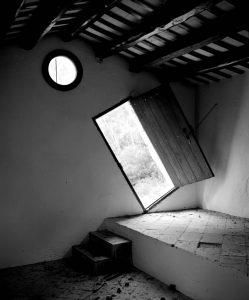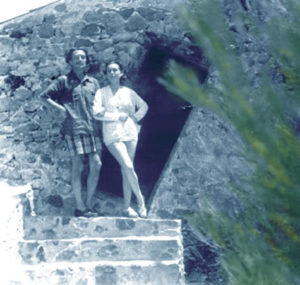Located on the outskirts of Platja d’es Castell, in Palamós, the so-called Barraca d’en Dalí is a small workshop, now empty, which nevertheless tells a curious story related to the brilliant painter.
The origin of the Barraca de Dalí is connected with a large estate called Mas Juny.
Mas Juny, originally an old farmhouse called Mas Crispí, with a circular defence tower, became quite famous when the famous painter Josep Maria Sert (author, among other international works, of the mural of the great Hall of the League of Nations in Geneva) acquired the estate in the 1920s.
Even then, the estate attracted a number of internationally renowned personalities, friends whom Sert had met on his travels through Europe and America, such as Marlene Dietrich, Visconti, Coco Chanel, Francesc Macià, Francesc Cambó and a very young Dalí. It was the interwar period, when the happy 1920s gave way to the second half of the 1930s, a time when both the Spanish Civil War and the outbreak of the Second World War took place.
In 1935 a tragedy occurred in Sert’s family circle. The brother of his then current and second wife, Prince Alexis Mdivani, died in a traffic accident in the Empordà town of Albons, on board his Rolls-Royce, while driving to France from the Mas Juny in the company of a Baroness of the Thyssen-Bornemisza family. Sert’s wife, Roussie, was so grief-stricken by the loss of her brother that she wanted to leave the place that brought back such bad memories, and so they moved away from es Castell.

However, the glamorous light of Mas Juny was not to be lost. In 1940 Sert (who died five years later) sold the house to the second great figure in this story: Alberto Puig Palau (1908-1986). Puig Palau was a handsome young man, the fifth son of a multimillionaire, who organised high-class parties in Barcelona and at the recently purchased farmhouse. Always on the winning side in the Civil War, Puig Palau enjoyed the regime’s favour.
In 1945 he built a tower on the estate, and to inaugurate it he organised a party with a bullfight and a tablao with Pastora Imperio. With a clear vocation as a patron of the arts, Puig Palau organised successive parties and invited the cream of the art and culture of the time. In the midst of the Spanish post-war period, Manolete, Carmen Amaya (who had not yet acquired Mas Pinc de Begur), a very young Lola Flores and Manolo Caracol, as well as the writer Josep Pla, all passed through that corner of es Castell.

Salvador Dalí was also a close friend of Puig Palau and took part in these parties. In a gesture of cordiality, Alberto had a workshop-studio built for Dalí to create his works: this was Dalí’s hut, to which he gave an original, surrealist touch by adding the slanted door.
Dalí gratefully received this detail. However, the brilliant painter’s work corner was already Portlligat at that time, so it seems highly unlikely that he ever used it. There is no record of Dalí ever having painted any work there.
As the Franco regime wore on, Alberto Puig Palau’s glory, and also his fortune, diminished. Joan Manuel Serrat also had the opportunity to meet him, and his admiration for the figure of this bourgeois who was so close to intellectual circles was such that he dedicated a song to him with the title of his nickname: “Tío Alberto” (Uncle Alberto).